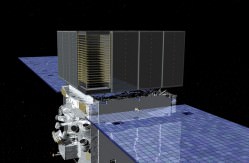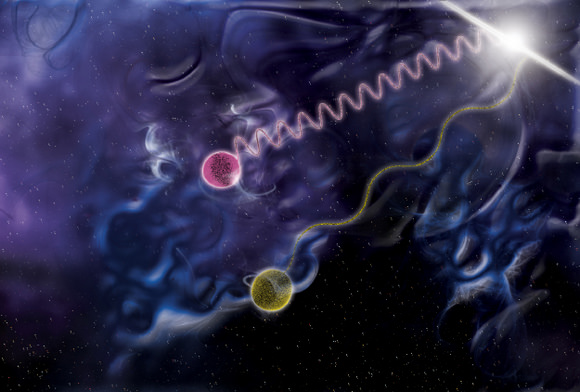[/caption]
While the Fermi Space Telescope has mapped the gamma ray sky with unprecedented resolution and sensitivity, it now has been able to take a measurement that has provided rare experimental evidence about the very structure of space and time, unified as space-time. Einstein’s theory of relativity states that all electromagnetic radiation travels through a vacuum at the same speed. Fermi detected two gamma ray photons which varied widely in energy; yet even after traveling 7 billion years, the two different photons arrived almost simultaneously.
On May 10, 2009, Fermi and other satellites detected a so-called short gamma ray burst, designated GRB 090510. Astronomers think this type of explosion happens when neutron stars collide. Ground-based studies show the event took place in a galaxy 7.3 billion light-years away. Of the many gamma ray photons Fermi’s LAT detected from the 2.1-second burst, two possessed energies differing by a million times. Yet after traveling some seven billion years, the pair arrived just nine-tenths of a second apart.
“This measurement eliminates any approach to a new theory of gravity that predicts a strong energy dependent change in the speed of light,” Michelson said. “To one part in 100 million billion, these two photons traveled at the same speed. Einstein still rules.”
“Physicists would like to replace Einstein’s vision of gravity — as expressed in his relativity theories — with something that handles all fundamental forces,” said Peter Michelson, principal investigator of Fermi’s Large Area Telescope, or LAT, at Stanford University in Palo Alto, Calif. “There are many ideas, but few ways to test them.”

Many approaches to new theories of gravity picture space-time as having a shifting, frothy structure at physical scales trillions of times smaller than an electron. Some models predict that the foamy aspect of space-time will cause higher-energy gamma rays to move slightly more slowly than photons at lower energy.
GRB 090510 displayed the fastest observed motions, with ejected matter moving at 99.99995 percent of light speed. The highest energy gamma ray yet seen from a burst — 33.4 billion electron volts or about 13 billion times the energy of visible light — came from September’s GRB 090902B. Last year’s GRB 080916C produced the greatest total energy, equivalent to 9,000 typical supernovae.
More images and videos about the Fermi Space Telescope.
Lead image caption: In this illustration, one photon (purple) carries a million times the energy of another (yellow). Some theorists predict travel delays for higher-energy photons, which interact more strongly with the proposed frothy nature of space-time. Yet Fermi data on two photons from a gamma-ray burst fail to show this effect. The animation below shows the delay scientists had expected to observe. Credit: NASA/Sonoma State University/Aurore Simonnet
Source: NASA

